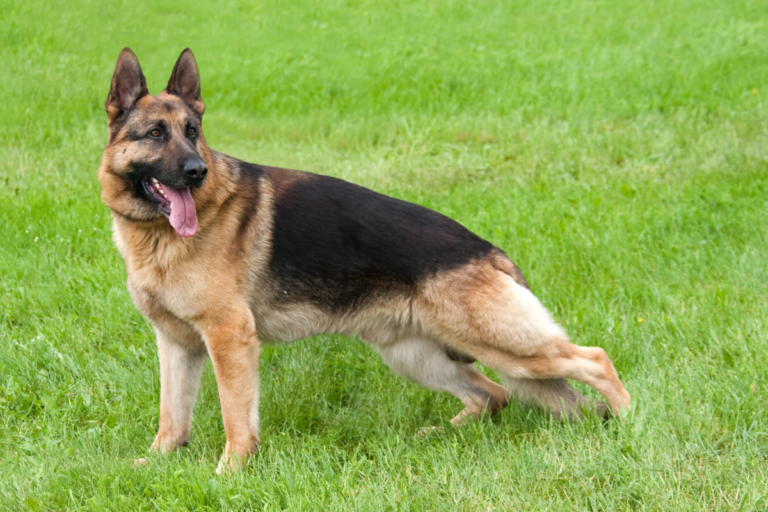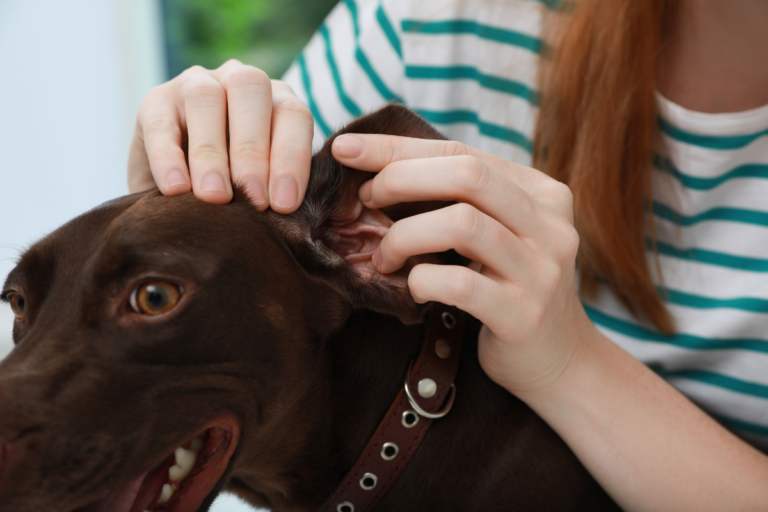Stay Vigilant: Early Symptoms of Fleas in Dogs You Should Know
Signs of Fleas in Dogs
Spotting flea symptoms early in your dog is a big deal for keeping them healthy and happy. Let’s break down the signs that could mean your pup is playing host to these annoying little critters.
Scratching and Chewing Behavior
If your dog suddenly turns into a scratching machine, there’s a good chance fleas are behind it. It’s not just a little itch—it’s more like a full-on scratching marathon that might even keep the household awake. They’re not only scratching; you might catch them gnawing at their fur too. This is them trying to get some relief from the irritating flea bites that just won’t quit.
Excessive Grooming and Hair Loss
A flea invasion can also turn your pooch into a compulsive groomer. This isn’t about looking sharp—it’s an act of desperation. You might see spots where the coat’s looking a little sparse or even bald patches from all that licking and biting. They’re basically trying to groom away the torment.
Agitation and Restlessness
Now, if your dog seems extra on-edge or restless, fleas could be the culprits. That constant flea frenzy can make any dog go a little bonkers, leading to pacing or increased restlessness. If your pup can’t seem to rest easy, fleas are probably to blame. And if things get really bad, it can make way for nastier problems like sore hot spots and even paler gums if the flea party gets out of hand.
Fleas do more than just bite—they can also stir up flea allergy dermatitis. It’s a mouthful but basically means lots of itching and skin troubles. Ignore it, and you might be looking at seeing your pup dealing with extreme hair loss or flaky skin that gets infected.
Seeing these red flags early means you can jump in and help your pooch sooner. For more scoop on flea troubles or other health quirks, pop over to our articles on dog diseases and tick symptoms. Catching the signs early ensures your furry buddy stays in tip-top shape and comfy.
Visual Indicators of Fleas
Let’s not just play detective with our dogs’ antics; let’s get down to some real evidence! When it comes to fleas, seeing is believing, and we’ve got the lowdown on spotting these pesky nuisances. Buckle up as we dive into the tiny world of fleas, their calling card—flea dirt—and those sneaky eggs they’d rather keep hidden.
Physical Presence of Fleas
Catching fleas in action? It’s as good as a guilty verdict in dog court. These creepy crawlers are small, about the size of a sesame seed, and they love to go for a ride through your dog’s fur. You’ll want to check out spots like the neck, ears, tummy, and the base of the wagging tail. If your pup’s been extra itchy or is running a marathon with its tongue, there’s a good chance fleas are on board.
| Hotspots for Flea Hangouts | Sneakiness Level (1-5 scale) |
|---|---|
| Neck | 5 |
| Ears | 4 |
| Lower Back | 3 |
| Tummy | 2 |
| Wagging Tail Base | 5 |
Identification of Flea Dirt
Ever seen tiny black pepper dots on your dog? That’s flea dirt, folks, not some fancy canine seasoning. These itty-bitty specks are flea leftovers – yikes! Here’s a neat trick: place a few on a damp paper towel. If you get that reddish-brown color, say hello to flea droppings.
| Spot the Flea Dirt | Investigation Notes |
|---|---|
| What It Looks Like | Tiny black specks, pepper-style |
| Where You’ll Find It | Hiding where fleas throw parties |
| Water Test | Reddish-brown surprise on a paper towel |
Feeling curious? Have a peek at our piece on bloat symptoms dog while you’re at it.
Observing Flea Eggs
Flea eggs are like the cryptic cousin in the flea family—small, white, and sneaky. Though they’re tough to spot on your dog, their presence is more visible in places your pawed pal frequents like their snuggle spots or usual hangouts. Keep an eye out for tiny salt-like grains, and remember, if something’s shaped like rice near your dog’s behind or in its poo, it could be tapeworms along for the ride.
Stay sharp, check out our doggie survival guide on dog diseases and symptoms for more knowledge bombs.
Keeping our canine companions flea-free means catching these clues early! If you’re itching (pun unintended) to learn more about dodging flea drama, scoot on over to our tips on flea preventatives treatments and dog heart disease. No more flea circus in your house, just pure pup joy!
Health Implications of Fleas
Fleas aren’t just a pest; they’re a four-legged health hazard waiting to munch on your dog’s blood. From itchy skin to unwanted hitchhiker diseases, these critters pack a punch in the health department. Knowing what to look for can keep our dogs hopping happily instead of scratching furiously.
Hot Spots and Skin Irritation
Flea bites are like a buffet of bug-induced itchiness for dogs, and if you’ve ever seen a dog really go to town on a scratch, you know what I mean. We’re talking about hot spots here—those nasty, inflamed patches that develop after relentless scratching, biting, and licking. These hot spots are painful and can turn into infections faster than you can say “vet visit.” The key? Catch ’em early and treat ’em right. Want more details on skin woes? Check out our info on ringworm dog symptoms.
Anemia and Muscle Loss
Little fleas have big appetites. Picture this: a flea can chow down on 15 times its own body weight in blood every day (American Kennel Club). For a heavily infested dog, especially those tiny puppies or smaller breeds, that means serious trouble. We’re looking at anemia here, folks – pale gums, zero energy, and muscle on the decline (BeChewy). If we let this slide, anemia can get nasty and potentially life-threatening. Watch closely for signs and call your vet if anything seems off. More on anemia over at our canine disease article.
Transmission of Tapeworms
Fleas also love to gift-wrap tapeworms for their canine buddies. Dogs munch on fleas during a grooming session, and — voila — tapeworm surprise! While not usually harmful, it’s best to nip this in the butt, pronto. Treating tapeworms is straightforward, but suspect something? Hit up your vet (American Kennel Club). We’ve got more info on dog diseases, including tapeworms, right here: dog diseases and symptoms.
Knowing these flea fiascos helps us keep a step ahead in protecting our furry pals. Looking for preventative tips? Head over to preventing flea infestations for some handy advice.
| Health Issue | Symptoms | Severity |
|---|---|---|
| Hot Spots and Irritation | Inflammation, Redness, Pain | Moderate |
| Anemia | Pale Gums, Lethargy, Muscle Loss | Severe |
| Transmission of Tapeworms | Weight Loss, Visible Worms in Stool | Mild to Moderate |
Keeping tabs on these flea-related issues will help us keep our tails wagging. Tackle treatment and prevention head-on, and our pups will stay in tip-top shape. For more dog health tips, check out our pieces on bloat symptoms dog and dogs teeth.
Flea Allergy Dermatitis
So, your dog is going to town on that scratch behind their ear again, huh? Welcome to the world of flea allergy dermatitis (FAD), where flea bites become about as welcome as a fly in your soup. Let’s break down what causes the itch, and what can be done to give your furball some relief.
Fleas: The Culprits Behind the Itch
When a flea takes a bite, it’s like opening a can of irritation for some dogs. Their saliva packs a punch, full of chemicals that can trigger an allergic reaction. Next thing you know:
- Your dog is doing the scratch and chew two-step, especially along their back, with bare patches from all that fur they’ve lost during their itchy battle.
- Open sores and scabs become part of the landscape—thank you, endless licking and chewing.
- The scratching invite unwanted guests: secondary infections, a fancy way of saying those pesky bugs have really stirred the pot (PetMD).
| Symptom | Spot in the Itch-Arena |
|---|---|
| Meandering itches | Back, tail hot zones |
| Bald patches | Mostly back, tail, but it can spread like wildfire |
| Scabs and sores | Where the scratch party’s at |
How Vets Sleuth Out the Problem
Getting to the root of FAD is like a detective story, minus the trench coat. You’ve got:
- Flea hunt: Armed with a fine-tooth comb, your vet’s on a mission to find fleas or their dirt on your dog.
- Blood clues: Blood tests sniff out if an allergy is pulling the strings.
- Skin sleuthing: Skin tests reveal what allergens are making your pup red in the face (or — you know — all over) (PetMD).
All these measures help separate FAD from other pesky skin mysteries like ringworm or yeast infections.
What to Do About It
Alright, you’ve found the culprit—now what? It’s time to show those fleas the exit:
- Evicting the Fleas: Break out the heavy hitters with oral meds or topical potions that do more than just talk about killing fleas—they actually do it.
- Soothing the Itch: Lend a hand with medicated shampoos and salves that call ‘truce’ to your dog’s skin.
- Blocking Return Visits: Keep up the line of defense with monthly flea and tick barriers (PetMD).
Don’t forget the power of a daily flea comb, tidying up the doggo digs, and maybe even calling in the pest-busters for a more professional spray-down. For even more bite-busting tips, check out our flea prevention and monthly maintenance.
By taking these steps, we’ll keep our canine pals itchin’ to play, not from fleas. Dive into our catalog of dog diseases for more scoop on ensuring your pup stays healthy and happy.
Preventing Flea Infestations
Keepin’ them pesky fleas off our dogs is not just about comfort but keeping ’em healthy and happy too! We’ll check out monthly treatments, spruce up the living space, and do a quick check on costs.
Monthly Preventative Treatments
No one wants a scratchin’, bitin’ mess, so monthly treatments are the way to go. Whether it’s chewable tablets or a little squeeze of liquid on the fur, these treatments keep fleas from setting up camp. Missing even a single dose can welcome those itchy buggers right back (WagWalking).
| Type of Treatment | How It’s Done | How Often |
|---|---|---|
| Oral | Tablet or Chew | Once a month |
| Topical | A few drops on the skin | Once a month |
Think about using flea collars, spot-on stuff, or pills for total peace of mind. Your vet’s the best buddy here, pointing out what’s best for your furball.
Environmental Control Measures
Monthly treatments are just half the battle. Fleas love to hang out in the cozy corners of our homes, so here’s how to kick ‘em out:
- Toss your dog’s bedding and blankets in the wash often.
- Give your pup a good check with a flea comb now and then.
- Vacuum like you’re prepping for a visit from the in-laws. Get those flea eggs and larvae out before they cause a fuss.
- Flea bombs or sprays are like eviction notices for any hiding fleas.
Keepin’ the home clean cuts down on uninvited flea parties.
Cost Considerations
Stopping a flea circus from starting up ain’t free, but it sure beats dealing with an infestation. The dollars can vary depending on how you handle things. Consider vet visits, meds, and maybe flea treatments for the house (Small Door Vet).
| Expense Type | Ballpark Figure |
|---|---|
| Vet Check | $50 – $100 |
| Monthly Flea Meds | $10 – $30 |
| Flea-Tackling Products | $20 – $50 |
| Home Treatments | $30 – $100 |
Shelling out on regular prevention is just plain smart. Skip the flea drama and save those pennies for more treats and toys.
For more tips on keepin’ Fido in tip-top shape and sniff out other health advice, check out articles on dog gum disease, ringworm dog symptoms, and healthy hounds.
Handling Flea Infestations
Got a flea problem with your pup? No worries, we’re on this! Spotting the signs, using the best tools, and picking the right treatments is the way to go. Let’s break it down:
Identifying Symptoms
When fleas crash the party on your dog, they don’t send invites, but they leave plenty of clues. We’re talking restless pups, their constant itch, scratching, excess licking, losing more fur than usual, bumpy scabs, and maybe even skin that’s thickened or darkened. Sometimes, there’s blood loss and our furry friends end up with anemia. Flea bites can be downright annoying and cause some dogs to have an allergic meltdown—constant chewing and biting at their skin like it’s going out of style.
Here’s What You See:
- Restlessness
- Scratch and lick fest
- Hair thinning out
- Scabbing
- Skin looking different—darker or thicker
- Blood loss leading to anemia
Want the whole lowdown on flea signs? Jump over to our page on symptoms of ticks in dogs.
Using a Flea Comb
Meet the flea comb, your new best friend! Run it through your dog’s coat like a detective. Focus on the neck, tail, and belly. You’re hunting for those little black dots—that’s flea dirt, and it’s like 99% proof your dog’s dealing with fleas.
Flea Comb How-To:
- Get a comb with super-fine teeth.
- Comb through that coat carefully.
- Inspect what gets trapped.
- Say goodbye to fleas like a pro.
Looking for more tricks to spot and stop fleas? Swing by our dogs and ticks page.
Treatment Products and Methods
So many ways to boot the fleas! Whether it’s through pills, skin drops, shampoos, or collars, each method brings its own brand of relief. Just pick what suits your dog’s style best.
| Treatment Type | What It Does | Example Products |
|---|---|---|
| Oral Medications | Flea fighters from inside out | Comfortis, Capstar |
| Topical Treatments | Right on the skin warriors | Frontline, Advantage |
| Flea Shampoos | Suds that hit fleas on contact | Adams Plus Flea and Tick Shampoo |
| Flea Collars | Round-the-clock neck wear | Seresto, Hartz UltraGuard |
Always follow your vet’s advice and the product’s instructions for the best outcome. A monthly regimen of oral or topical treatments can prevent future unwelcome guests.
Let’s not forget their hangout spots—like bedding, carpets, and the yard. It’s cleaning time there too! Check out our tips on flea comb tips for more action plans.
By catching symptoms early, using handy tools like the flea comb, and going for the right treatment, we keep our pets safe and sound. Stay sharp and deal with fleas before they make themselves too cozy. For more reads on keeping your pet in top shape, explore our articles on flea allergy dermatitis, dog gum disease, and bloat symptoms dog.






